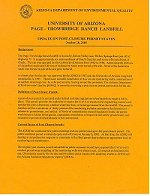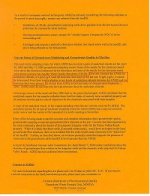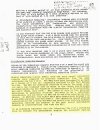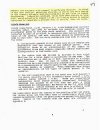| Details of the ADEQ admission
The
University of Arizona owns the Page-Trowbridge landfill and is responsible
for periodically monitoring the groundwater for contamination by the landfill.
The U of A maintains four monitoring wells spaced hundreds of feet apart
around the Page-Trowbridge radioactive/toxic waste landfill. Water
from these wells is sampled twice a year and analyzed to determine if the
hazardous wastes buried at the landfill have begun to infiltrate the groundwater.
Reports with the results of the analysis of every test are sent to ADEQ.
ADEQ's admission
The admission by ADEQ that they don't know if the water beneath Page-Trowbridge
is contaminated with methylene chloride or not, is worded as follows:
"The most recent sampling
events for which ADEQ has received copies are the April 26, 2000 and May
17, 2000 ground water sampling events. None of the results for the
chemicals tested were above the detection limits used by the laboratory
and none of the results for the chemicals tested were shown above the Aquifer
Water Quality Standards [AWQS].
The flyer continues (emphasis supplied):
"However, because the AWQS
for methylene chloride is 5 ppb [ppb = Parts Per Billion] (ug/L) and the
detection limit used by the lab was 10 ppb (ug/L), it
cannot be determined from these results whether or not levels of methylene
chloride between the AWQS and the detection limit were present."
Since the Aquifer Water Quality Standard
is 5 ppb and the detection limit used for methylene chloride at Page-Trowbridge
is 10 ppb, the ADEQ statement, "it cannot be determined
from these results whether or not levels of methylene chloride between
the AWQS [5 ppb] and the detection limit [10 ppb] were present,"
means that the ADEQ does not know if methylene chloride contamination exists
at levels between 5 ppb and 10 ppb.

ADEQ flyer, page 1
|

ADEQ flyer, page 2
(ADEQ admission on this
page)
|
click on images for
larger view
What ADEQ does know
Because ADEQ tells us that "None of the . . . chemicals tested were above
the detection limits" and that "the detection limit used by the lab [for
methylene chloride] was 10 ppb", ADEQ knows that the level of methylene
chloride is 10 ppb or less.
What ADEQ doesn't know
ADEQ's statement that they do not know if methylene chloride contamination
exists at levels between 5 ppb and 10 ppb, is an admission that ADEQ doesn't
know the level of methylene chloride contamination in the water supply.
Specifically, if ADEQ knew the level of methylene chloride contamination,
then ADEQ would have to know whether the level of contamination was between
0 ppb and 5 ppb or between 5 ppb and 10 ppb.
For example, if the level of methylene chloride contamination was 9.99
ppb, ADEQ would be able to determine that the contamination level was between
5 ppb and 10 ppb. Yet ADEQ tells the reader that "it
cannot be determined . . . whether or not levels of methylene chloride
between the AWQS [5 ppb] and the detection limit [10 ppb] were present."
Similarly, if the level of methylene chloride contamination was
1 ppb, ADEQ would be able to determine that the contamination level was
not
between 5 ppb and 10 ppb. Yet ADEQ tells the reader that "it
cannot be determined . . . whether or not levels of methylene chloride
between the AWQS [5 ppb] and the detection limit [10 ppb] were present,"
Since ADEQ says that "it cannot be determined . .
. whether or not levels of methylene chloride between the AWQS [5
ppb] and the detection limit [10 ppb] were present," it follows that ADEQ
doesn't
know the level of methylene chloride contamination in the water supply.
ADEQ doesn't know if
the water supply is contaminated or not
ADEQ doesn't know if the the groundwater beneath Page-Trowbridge is contaminated
with 9.99 ppb of methylene chloride or is completely free of methylene
chloride.
In other words, ADEQ doesn't have any idea if the water supply is contaminated
with methylene chloride or not.
Twice the legal limit
The maximum contamination level allowed for methylene chloride by federal
law is 5 ppb. The detection limit used for methylene chloride
is 10 ppb.
Because ADEQ tells us that "None of the . . . chemicals tested were above
the detection limits" and that "the detection limit used by the lab [for
methylene chloride] was 10 ppb", ADEQ knows that the level of methylene
chloride is 10 ppb or less. ADEQ just doesn't know what the actual
level is.
In other words, the groundwater beneath Page-Trowbridge could contain 9.99
ppb of methylene chloride, twice the amount of contamination allowed by
federal law, and the ADEQ would not know it.
"...none of the ... chemicals
tested were shown above the Aquifer Water Quality Standards"
The ADEQ flyer says that "the Aquifer Water Quality Standards for
methylene chloride is 5 ppb" and also tells us that "none of the ... chemicals
tested were shown above the Aquifer Water Quality Standards."
At first, this may seem to contradict the statement by ADEQ that "it
cannot be determined . . . whether or not levels of methylene chloride
between the AWQS [5 ppb] and the detection limit [10 ppb] were present".
How could ADEQ say that "it cannot be determined
. . . whether or not levels of methylene chloride between the AWQS
[5 ppb] and the detection limit [10 ppb] were present" and also say that
"none
of the ... chemicals tested were shown above the Aquifer Water Quality
Standards"?
The key to understanding this apparent contradiction is understanding how
water test results use the detection limit.
Detection limits and Water
quality reports
When
contamination is found in an amount above the detection limit, the laboratory
reports the specific amount found.
When contamination is found in an amount below the detection limit, the
laboratory does not report the amount found, but merely reports that the
contaminant was less than the detection limit.
In other words, when contamination is found in an amount below the detection
limit, the laboratory does not show the amount found on the report. Because
the detection limit for methylene chloride is 10 ppb at Page-Trowbridge,
the reports do not show amount of methylene chloride detected in amounts
less than 10 ppb.
Because the reports from the tests on groundwater from the PageTrowbridge
monitoring wells do not show the specific amount of methylene
chloride detected, the ADEQ can report that, "none of the results for the
chemicals tested were shown above the Aquifer Water Quality Standards,"
and be technically correct.
While the ADEQ statement that "none of the ... chemicals tested were shown
above the Aquifer Water Quality Standards" is technically correct, it is
completely misleading.
The reason that methylene chloride contamination was not shown to be above
the Aquifer Water Quality Standards, is simply because the specific amount
of methylene chloride contamination detected in groundwater from beneath
Page-Trowbridge is not shown on the reports.
ADEQ has known of potential
contamination for at over 8 years
ADEQ has known that the water beneath Page-Trowbridge could potentially
be contaminated with twice the amount of methylene chloride allowed by
law for 8 or more years.
Earlier
detection of methylene chloride and other contaminants at the Page Trowbridge
monitoring wells have been dismissed by the U of A as errors made by the
independent laboratories that analyzed the water sampled from the wells.
In spite of claiming that the detection of methylene chloride was the result
of lab errors, the U of A, raised their reporting limits for methylene
chloride by a factor of 5, from 2.0 ppb to 10.0 ppb, in 1992
An attachment to a letter from ADEQ to the U of A dated July 27, 1993,
tells us that ADEQ was concerned about this unusually high limit, 7 years
ago.

|

|
Document showing ADEQ
aware of irregular reporting method 8 years ago
(Click on images for larger
view)
|
|
ADEQ has known that they don't know whether the groundwater beneath the
Page-Trowbridge radioactive/toxic waste landfill is contaminated with twice
the legal dose of methylene chloride or not for at least 8 years.
No corrective action taken
As of this writing ADEQ has taken no action to address their long-standing
concern regarding the unusually high detection limits for methylene chloride,
other than write letters to the University of Arizona. No enforcement
or regulatory action has been taken by ADEQ to remedy the situation.
The last letter the ADEQ sent to the U of A complaining about the unusually
high detection limits was sent Sept. 1 of this year.
No corrective action planned
As of this writing, the ADEQ has not indicated that they have any plans
to adopt normal and accepted reporting methods that will show massive groundwater
contamination.
ADEQ permits testing to be
bypassed
In addition to taking no action to remedy the situation at Page-Trowbridge
which could result in the water supply being contaminated with methylene
chloride at twice the legal limit, ADEQ has been allowing water companies
that pump water from the aquifer under Page-Trowbridge to bypass testing
for methylene chloride.
1997 The Arizona Water Company detected the presence of methylene chloride
in water samples taken from the aquifer, and reported these results to
ADEQ.
The amount detected was 0.6 ppb, but could have been as high as 1.2 ppb,
or 24% of the limit allowed by law for methylene chloride.
ADEQ then granted waivers allowing The Arizona Water Company to forego
any further testing for methylene chloride.
Why methylene chloride is regulated
Methylene chloride is a volatile organic compound that can cause
cancer. Other health effects of exposure to methylene chloride include
damage to the nervous system and blood as well as liver damage.
Any Exposure Potentially Dangerous
The EPA has Maximum Contamination Level Goals, called MCLG's for each hazardous
compound that they regulate. The EPA sets the MCLG based on the amount
of a contaminant that can be consumed without any risk to health.
The MCLG for methylene chloride is zero, which means that the EPA considers
any exposure to methylene chloride potentially dangerous to health. |
![]()
![]()
![]() email:mekazda@mindspring.com
email:mekazda@mindspring.com